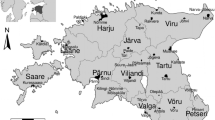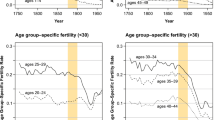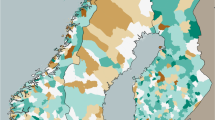Abstract
According to the demographic transition theory, fertility rates fall in response to declines in child mortality rates. Although national statistics indicate that child mortality rates have been declining over time, Ghana’s fertility rates appear to have stalled. This paper hypothesises that women’s fertility behaviours may be more responsive to child mortality experiences at more localised levels. Using all rounds of the Ghana Demographic and Health Surveys (1988–2008) and employing a variety of spatial and empirical estimation techniques, results indicate that in addition to own-child mortality, neighbourhood child mortality shocks are also a determinant of women’s fertility in Ghana. Women in neighbourhoods with large child mortality shocks may desire more children as an “insurance” against future losses, as a result of their increased perceptions of own-child mortality risks.




Similar content being viewed by others
Notes
No spatial data are available for 1988.
Results are presented for the negative binomial regression model in Appendix B.
Regression results using the negative binomial regression model presented in Appendix C.
References
Malmberg, B.: Demography and the development potential of Sub-Saharan Africa. Stockholm: Department of Human geography, Stockholm University. p. 34. (2008)
Agyei-Mensah, S.: Fertility transition in Ghana: looking back and looking forward. Population. Space Place 12, 461–477 (2006)
Montgomery, M. R., Cohen B. (eds.): From Death to Birth: Mortality Decline and Reproductive Change Committee on Population, National Research Council (1998)
Ghana Statistical Service (GSS), Ghana Health Service (GHS), and ICF Macro: Ghana Demographic and Health Survey 2008. GSS, GHS, and ICF Macro, Accra (2009)
Van Poppel, F., Reher, D.S., Sanz-Gimeno, A., Sanchez-Dominguez, M., Beekink, E.: Mortality decline and reproductive change during the Dutch demographic transition: revisiting a traditional debate with new data. Demogr. Res. 27(11), 299–338 (2012)
Easterlin, R.A.: An economic framework for fertility analysis. Stud. Fam. Plann. 6(3), 54–63 (1975)
Becker, GS.: An economic analysis of fertility. In Demographic and Economic Change in Developed Countries. Princeton, NJ: Princeton University Press and NBER. (1960)
Pritchett, L.H.: Desired fertility and the impact of population policies. Popul. Dev. Rev. 20(1), 1–55 (1994)
Cleland, J., Phillips, J., Amin, S., Kamal, G.: The Determinants of Reproductive Change in Bangladesh: Success in a Challenging Environment. The World Bank, Regional and Sectoral Studies, Washington DC (1994)
Bongaarts, J., Watkins, S.: Social interactions and contemporary fertility transitions. Popul. Dev. Rev. 22(4), 639–682 (1996)
Casterline, J. Diffusion Processes and Fertility Transition: Introduction. Diffusion Processes and Fertility Transition: Selected Perspectives, Committee on Population, National Resource Council. (2001)
Smith, J.: Contradictions in Nigeria’s fertility transition: the burdens and benefits of having people. Popul. Dev. Rev. 30(2), 221–238 (2004)
Schultz, P.: Demand for children in low-income countries. Handbook Popul. Family Eco. 1A, 349–430 (1997)
Haaga, J.G. Mechanisms for the Association of Maternal Age, Parity and Birth Spacing with Infant Health. RAND, Note N-2991-RE (1991)
Heffner, L.: Advanced maternal age- how old is too old? N. Engl. J. Med. 351(19), 1927–1929 (2004)
Becker, G. S., Lewis, H. G. On the Interaction between the Quantity and Quality of Children. The Journal of Political Economy, Vol. 81, No. 2, Part 2: New Economic Approaches to Fertility (Mar. -Apr.), pp. S279-S288. (1973)
Bhat, M. Micro and macro effects of child mortality on fertility: the case of India. In: Montgomery, M. and Cohen, B. (Eds.). From death to birth: mortality decline and reproductive change. Washington DC: National Academy Press: 339–383. (1998)
Cleland, J.: The effects of improved survival on fertility: a reassessment. In: Bulatao, R.A., Casterline, J.B. (eds.) Global Fertility Transition, pp. 60–92. Population Council, New York (2001)
Kirk, D.: Demographic transition theory. Popul. Studies 50(3), 361–387 (1996)
Behrman, J. R., Duryea,S., Szekely, M. Decomposing fertility differences across world regions and over time: Is improved health more important than women’s schooling?, Office of the Chief Economist Working Paper No. 406. Washington, DC: Inter-American Development Bank. (1996)
Galloway, P. R., Lee R. D., Hammel E., A. Infant mortality and the fertility transition. In: Montgomery M.R. and B. Cohen (eds.), From Death to Birth: Mortality Decline and Reproductive Change. Washington, DC: National Academy Press, pp. 182–226. (1998)
Benefo, K., Schultz, T.P.: Fertility and child mortality in cote d’ivoire and Ghana. The World Bank Eco. Rev. 10(1), 123–158 (1996)
Conley, D., McCord, G.C. Sachs, J. D. Africa’s Lagging Demographic Transition: Evidence from Exogenous Impacts of Malaria Ecology and Agricultural Technology. NBER, Working Paper 12892 (2007)
Becker, G. S. A Treatise on the Family. Enlarged ed., Cambridge, MA,USA: Harvard University Press (1981)
Obeng-Gyimah, S., Fernando, R.: Intentional replacement of dead children in sub-saharan Africa: evidence from Ghana and Kenya. Canadian Studies Popul. 31(1), 33–53 (2004)
Basu, A.M.: Maternal Education, Fertility and Child Mortality: disentangling Verbal Relationships.”. Health Transit. Rev. 4, 207–215 (1994)
Anselin, L.: Exploring Spatial Data with Geoda: A Workbook. Center for Spatially Integrated Social Science (2005)
Makinwa-Adebusoye P. Changes in the Costs and Benefits of Children to their Parents. In: Locoh, T., Hertrich, V. (eds.) The Onset of Fertility Transition in sub-Saharan Africa. IUSSP. (1994)
Bongaarts J. The Causes of Stalling Fertility Transition. Population Council Working Papers No.204. Policy Research Division. (2005)
Gibson, M., Mace, R.: Labour saving technology and fertility increase in rural Africa. Curr. Anthropol. 43, 213–222 (2002)
Pence, B., Nyarko, P., Binka, F.N., Phillips, J.F., Debpuur, C.: The impact of the Navrongo Community Health and Family Planning Project on child mortality, 1993–2000. Paper presented at the Global Conference of the International Union for the Scientific Study of Population, Salvador, Brazil (August) (2001)
Debpuur, C., Phillips, J.F., Jackson, E.F. et al.: The impact of the Navrongo Project on contraceptive knowledge and use, reproductive preferences, and fertility. Stud. Family Planning 33, 141–163 (2002)
Durlauf, S.N., Walker, J.: Social interactions and fertility transitions. In: Casterline, J.B. (ed.) Diffusion processes and fertility transition: selected perspectives, pp. 115–137. National Academy Press, Washington, DC (2001)
Caldwell, J.: Paths to lower fertility. BMJ 319, 985–987 (1999)
Bongaarts, J.: Can family planning programs affect high desired family size in Sub-Saharan Africa? Int. Perspect. Sexual. Reprod. Health 37, 209–216 (2011)
Author information
Authors and Affiliations
Corresponding author
Rights and permissions
About this article
Cite this article
Owoo, N.S., Agyei-Mensah, S. & Onuoha, E. The effect of neighbourhood mortality shocks on fertility preferences: a spatial econometric approach. Eur J Health Econ 16, 629–645 (2015). https://doi.org/10.1007/s10198-014-0615-3
Received:
Accepted:
Published:
Issue Date:
DOI: https://doi.org/10.1007/s10198-014-0615-3
Keywords
- Fertility intentions
- Child mortality
- Spatial econometrics
- Neighbourhood shocks
- Demographic transition
- Ghana




